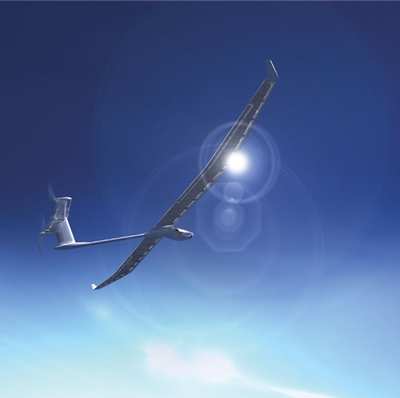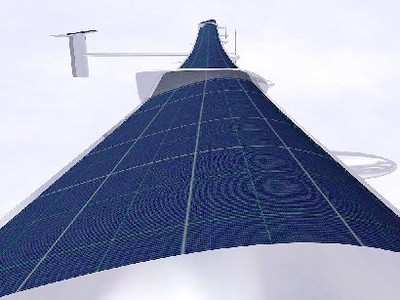Plane Will Recreate Notable Aviation Journeys
Sporting wings the width of the largest Airbus, a solar-powered
plane is scheduled to retrace several notable exploits in aviation
history -- including Charles Lindbergh's first transatlantic
crossing -- before attempting a round-the-world flight in
2011.

The "Solar Impulse" project, led by Swiss balloon pioneer
Bertrand Piccard, conducted some real-time computer simulations of
a circumnavigation this week, a full year before a prototype is due
for its maiden voyage.
As ANN reported, in 2005,
Piccard is no stranger to adventure. He made his first attempt at a
nonstop around-the-world balloon flight in 1999 with co-pilot Brian
Jones. They were successful on the third attempt.
"Solar Impulse will promote the idea of a new aviation era using
cleaner planes powered by the almost infinite energy of the sun
rather than the dirty, finite reserves of fossil fuels," said
Piccard at the time.
Virtual flights can be followed on the Internet. They're
designed to replicate long-distance journeys through real weather
conditions by the high-tech but lightweight and slow-moving
aircraft, according to Agence-France Presse.

The ground crew will attempt to ensure Solar Impulse has maximum
exposure to the sun during the day to keep its batteries charged,
and will guide it either around or above turbulence, heavy winds
and bad weather.
Each of the five legs of the around-the-world flight should last
three to five days.
"We have no idea if the virtual flight will be a success or not.
We're dealing with real conditions, so it may be a failure,"
Piccard said. "It's a real opportunity to learn."
The Solar Impulse team insists they are going to attempt not
only the first non-stop crossing of the United States by a solar
powered aircraft, but a first transatlantic flight before they set
off around the world in May 2011.
"My dream is for a flight one day from New York to Paris, this
is the most difficult because of the weather," said team
meteorologist Luc Trullemans.
"For the first time in my life I'm always looking for sunshine,"
he added.

The carbon-fiber Solar Impulse will have a wingspan of about 262
feet -- roughly equivalent to that of an Airbus A380. The aircraft
boasts 690 square feet of solar panels, but will weigh just a
little more than two tons and will barely accommodate the lone
pilot -- Piccard -- in its narrow, highly-computerized cockpit.
The aircraft's solar panels charge ultralight lithium batteries,
which in turn power four electric propeller engines along the
wings.
Piccard denies the $94 million project is a template for a
solar-powered commercial airliner, but is instead designed to
stimulate ideas for pollution-free travel.

"What's sure is that if we consume energy like we do now, we're
going to the wall. Solar Impulse shows how solar energy can be
attractive, it's showing that new energy is sexy," he said.
Piccard says current attempts at solar powered flight are
"largely anecdotal," because they're short jaunts in daylight in
perfect weather.
"That doesn't show the potential of solar power, it shows its
limits," he added.
The prototype is currently being designed and built in
Switzerland. The team is using innovative and even untested
technology to achieve their goal.
Piccard said the idea of Solar Impulse occurred, in part, from
being told balloon flight was the last challenge available.
"It became obvious that the adventures of the 21st century would
not be adventures of conquest, but adventures to improve the
quality of life," he explained.

Piccard comes from a long line of pioneers. His grandfather,
Auguste, and associate Paul Kipfer, were the first humans to fly
into the stratosphere in the 1930s in a balloon. Whereas his
father, Jacques, went the opposite direction and scored the deepest
dive in history reaching 35,810 ft in a submarine in the Marianas
Trench in 1960.
 ANN's Daily Aero-Linx (04.16.24)
ANN's Daily Aero-Linx (04.16.24) Aero-News: Quote of the Day (04.16.24)
Aero-News: Quote of the Day (04.16.24) Airborne 04.10.24: SnF24!, A50 Heritage Reveal, HeliCycle!, Montaer MC-01
Airborne 04.10.24: SnF24!, A50 Heritage Reveal, HeliCycle!, Montaer MC-01 Airborne 04.12.24: SnF24!, G100UL Is Here, Holy Micro, Plane Tags
Airborne 04.12.24: SnF24!, G100UL Is Here, Holy Micro, Plane Tags Airborne-Flight Training 04.17.24: Feds Need Controllers, Spirit Delay, Redbird
Airborne-Flight Training 04.17.24: Feds Need Controllers, Spirit Delay, Redbird







